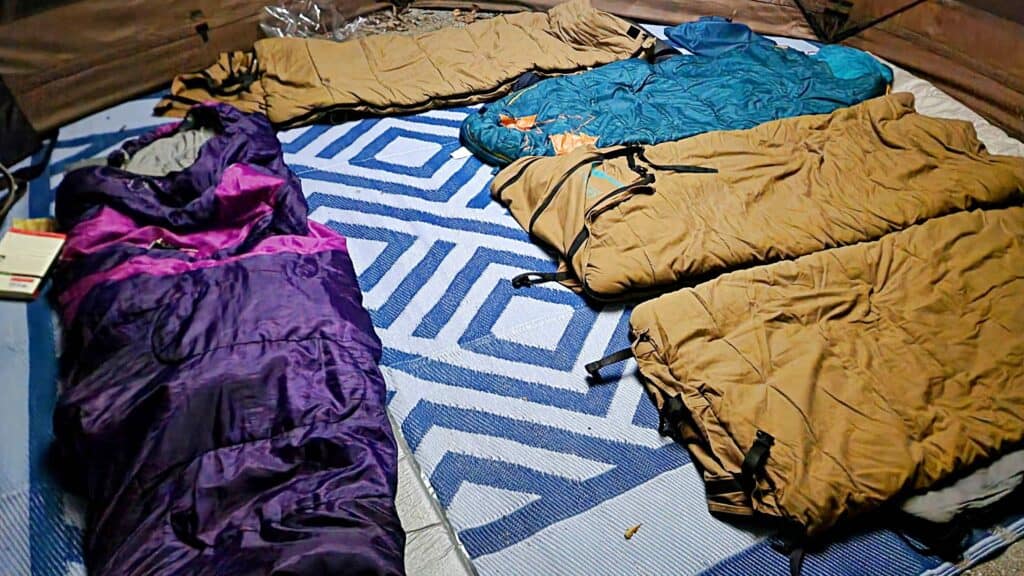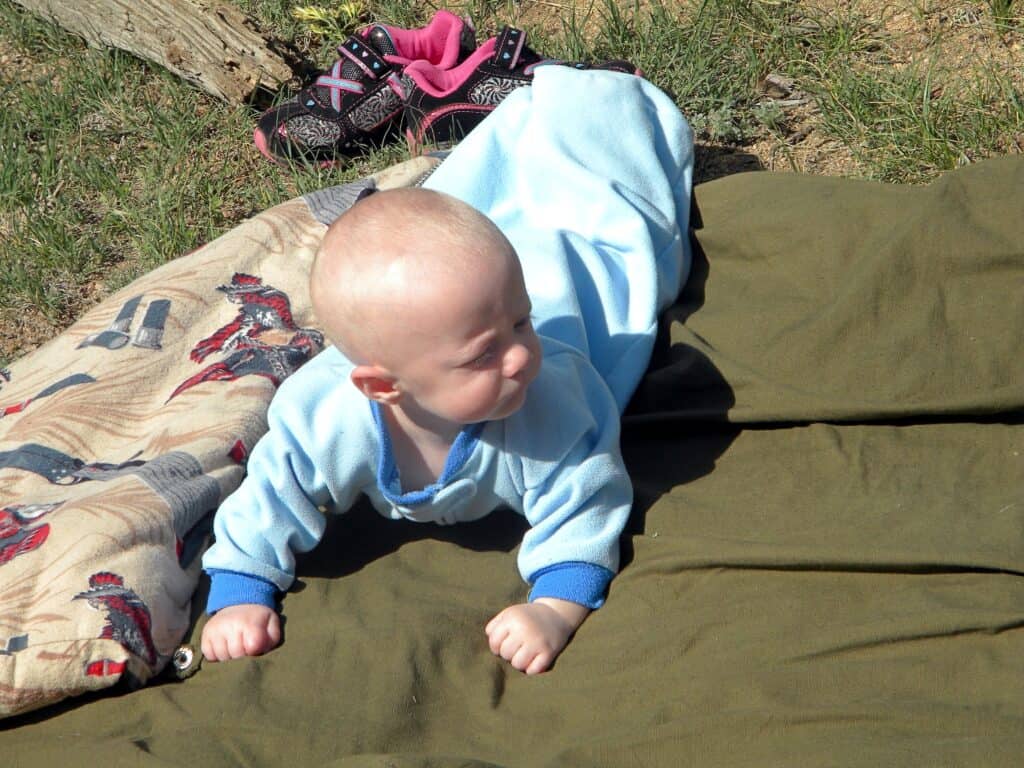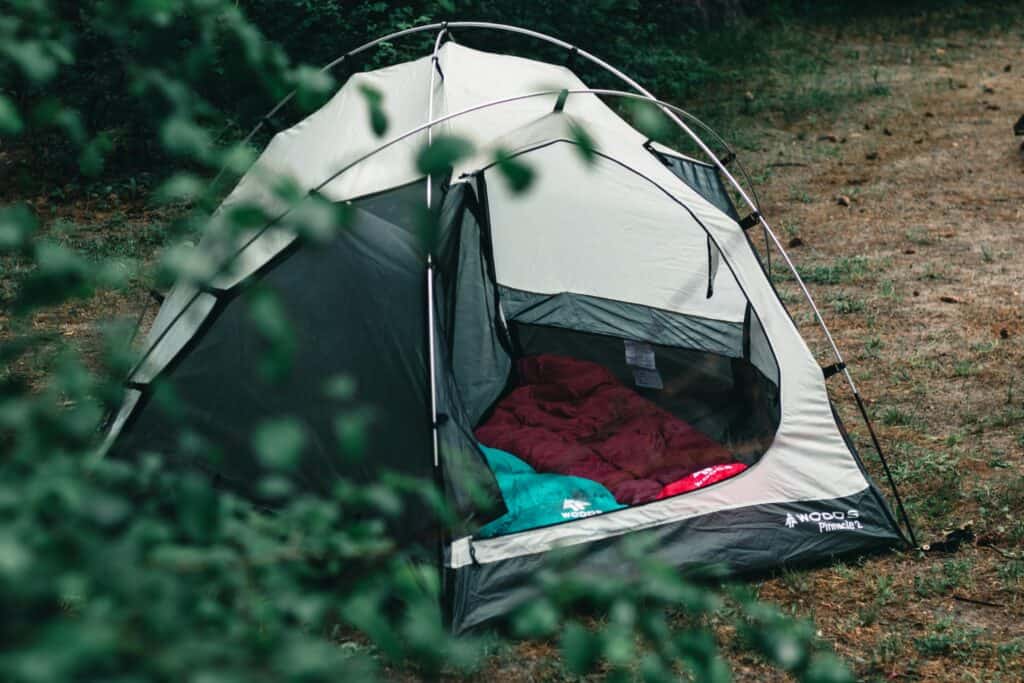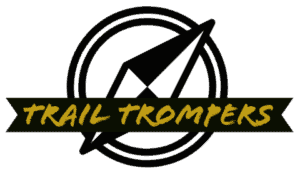Camping with a baby presents some challenges, such as planning what babies should sleep in while camping.
Babies can sleep in warm pajamas and baby sleeping bags while camping. Some babies do fine sleeping on a firm sleeping pad, while others will be safer and more comfortable in a portable crib. If the weather is warm, they may be able to sleep using thick pajamas instead of a sleeping bag.
Here are my best tips for sleeping in a tent with your baby:
How to Sleep in a Tent With a Baby
Sleeping in a tent with a baby can be challenging, but planning ahead can help make it easier. First, identify the struggles that you expect your baby to have. You know your child best: Is he going to have a hard time relaxing in a strange place, or is he more likely to be startled awake by strange sounds outside the tent?
Once you’ve identified the sleeping challenges your baby is likely to have, it’s easier to take steps to prepare for the best night possible. Pack what you think will help your child sleep based on what you know about your baby. Don’t focus on what other people, influencers, me (or even your mom) say if it doesn’t make sense given what you know about your baby.
That said, there are some basic tips and tricks that new campers might not think of and questions you are likely to have about how to help your baby fall asleep, what they should sleep in, and more. Knowing the answers to common questions and how other campers have handled this can help you strategize your own method.
How to Dress Your Baby to Sleep in a Tent
Babies usually wear warm pajamas to sleep when camping. They shouldn’t wear the clothes they played in all day, as they may be damp or dirty and it’s important to keep their sleeping bag clean. We usually bring one or two pairs of pajamas on a camping trip. Sleepers, footy pajamas, and long-sleeved rompers are all suitable.
Inside Tip: If you are worried about diaper leaks in your expensive sleeping bag, you can try doubling your baby's diaper for the night. What the first diaper doesn't catch, the second may.
If you’re trying to economize with your packing, there are ways to skip bringing pajamas. We often skip the pajamas while traveling by having our kids put on the next day’s clothes each evening. They get to sleep in clean, dry clothes and are ready to go as soon as they wake up. Make sure you bring clothes that are comfortable to sleep in, like leggings. For babies, this is especially easy as baby pajamas are very similar to their normal play clothes. (Note: There are times this doesn’t work well, for example, if your kids sweat a lot while sleeping or if they need to look nice the next day. When camping, this is rarely a problem.)

Finding a Safe Sleeping Bag
It isn’t safe for babies to use ordinary sleeping bags. Just like at home, blankets and sleeping bags can form a suffocation risk if your baby wiggles underneath them. Babies and toddlers can also get cold if they end up outside their sleeping bags.
If you need a sleeping bag for your baby, the best option is to choose a baby-safe sleep sack. These sleeping bags are designed to keep a baby or toddler warm while camping without the risk of them getting trapped inside or crawling out and getting cold. These are ideal if you need a true sleeping bag, such as when it’s cold at night, or if you plan to camp frequently.
If you’re camping less often and it won’t be cold at night, there are other options for keeping your baby warm without the expense of a sleeping bag. If the temperature doesn’t get below 60-70° at night, consider putting your baby in a warm sleeper and a normal sleep sack designed for indoor use.
Insider Tip: Is a baby sleeping bag too expensive for you? Instead, try using a snowsuit, which is cheaper and more versatile while still being warm and safe.

Tips to Help Your Baby Fall Asleep in a Tent
Babies can have a hard time falling asleep in new places. Some babies are used to being rocked to sleep or can fall asleep easily anywhere, while others need their own bed and space in order to relax.
Tips for Babies That Prefer Their Own Bed
One of my babies couldn’t fall asleep anywhere but a crib, making all sorts of outings incredibly difficult, from church services to camping trips. However, she did learn to sleep in a travel crib. For these babies, I would prioritize purchasing a tent large enough to accommodate a portable crib. It’s worth it for you and your baby to both get a good night’s sleep.
As an added advantage, your portable crib can double as a playpen while camping, such as when you need to put your baby down but want to keep them off the ground. Plus, a portable crib will help your baby stay warmer by keeping them off the cold ground and will help keep them safe. You can even get small portable bassinets for small infants which will take up less room (but can only be used for a few months).

A full-size portable playpen is big enough for babies and toddlers and can be used as both a bed and a playpen.
Tips for Babies That Wake Easily
If your baby wakes easily at night, strange noises such as crickets, other campers partying, and owls might be enough to keep her up all night long. She could even wake from the noisy sound of your sleeping bag crackling when you roll over! For these kiddos, consider having white noise playing in your tent. This will help muffle strange sounds and keep your baby asleep. You could play music or white noise on your phone, but it will drain your battery. You could also try using a battery-operated portable white noise machine. It might help the adults sleep better, too!
If your baby wakes often to eat or drink, be prepared to nurse regularly or have bottles of water prepared. If you breastfeed, make sure you wear clothes that you can easily nurse in. Also, use a sleeping bag big enough for your little one to fit inside or one that unzips easily. If you bottle-feed, have bottles of water ready. You can pre-measure the formula and it will be ready to dump into your pre-filled water bottles (heating isn’t required). This will keep you from needing to leave the tent for night-time feedings.
Sometimes, older babies and toddlers wake at night because they’re thirsty, not hungry. Remember, being outside all day can be dehydrating. Have sippy cups or bottles of water handy for your kiddos (and yourself!) at night.
Tips for Co-Sleeping Babies
Are you a co-sleeping family? If so, you already know that many experts consider co-sleeping to be safe when certain rules are followed. Co-sleeping in a sleeping bag, however, is questionable. Because sleeping bags are so thick and often zip up tightly, they don’t follow safe sleep guidelines (which emphasize not using heavy blankets). One solution is to create a bed-like arrangement instead of using a sleeping bag. This should be firm (not an air mattress) and have loose blankets that allow you to sleep the way you do at home, following co-sleeping rules. This option isn’t useful if it’s cold at night, as it won’t be warm enough to sleep without heavy blankets.
A better option, and one that works in colder weather, may be for you and your baby to each have separate (safe) sleeping bags, and simply lay your baby nearby so you can reach out of your bag and touch them when they get restless. Remember, if they sleep directly next to you, your own sleeping bag could inadvertently get over their face as they scoot around looking for you, so they should sleep a safe distance away.
Remember: Co-sleeping is never safe if you've been drinking, and if you don't co-sleep at home, you shouldn't do it when you're camping.

Conclusion
Sleeping in a tent with a baby presents its own unique challenges, but it can be done successfully and safely if you plan ahead and think about your baby’s personality and needs.





